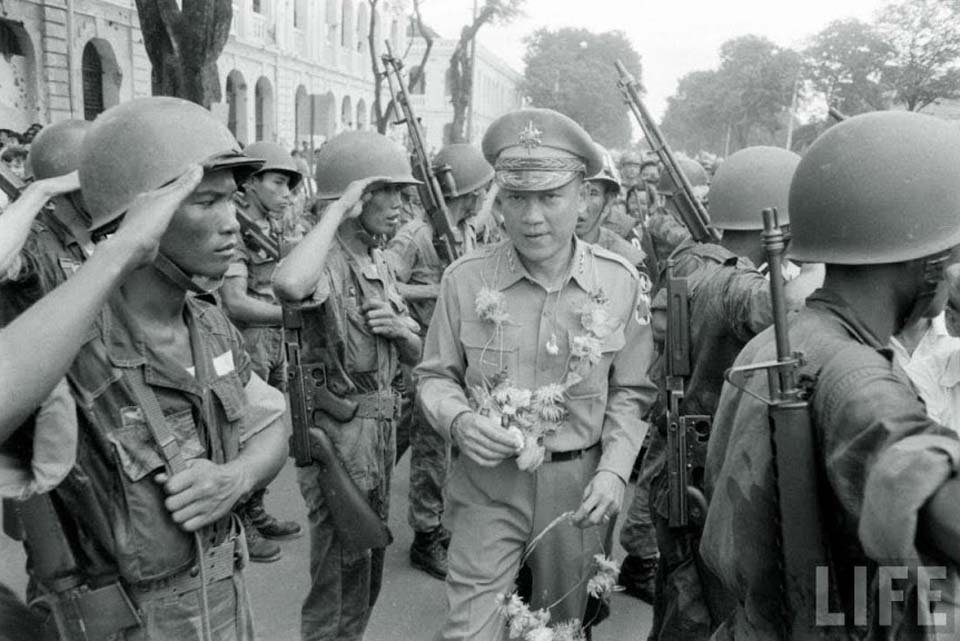Cụ
Ngao5 ơi, ảnh đầu tiên không phải của cuộc đổ bộ này.
Khẩu M16 trên vai lính Mỹ mãi năm 66-67 mới đưa vào trang bị cho lính Mỹ.
[/QUOTE]
Nhiếp ảnh gia Francois Sully, người Pháp, người đã chứng kiến chính quyền Sài gòn từ những ngày trứng nước, cũng là nhiếp ảnh gia riêng của ông bà Ngô Đình Nhu đến trước 1962 (sau 1962 là Larry Burrows). Năm 1965, ông có chụp một số hình ảnh cuộc đổ bộ của TQLC lên Đà Nẵng, Đây là hình chụp năm 1965, còn tại sao lại là 1967 thì em không rõ.
Kính cụ
Nguồn:
https://www.google.com/search?q=Francois+Sully+american+Soldier+1965&safe=active&tbm=isch&source=iu&ictx=1&fir=gs6gfZ-7ybh1sM%3A%2C66H1fU93ZdA1eM%2C_&vet=1&usg=AI4_-kTxRBz-Jx5ecM4cyBRTEuqNeNn1UA&sa=X&ved=2ahUKEwjpqLC65pPoAhXFDaYKHV8bCE0Q9QEwAHoECAcQBQ#imgrc=gs6gfZ-7ybh1sM:
Photos From 1965 Vietnam by Francois Sully / NEWSWEEK
Caption by Malcolm Jones
The United States began its involvement in Vietnam in the mid-1950s, and almost immediately the government’s sketchy nomenclature underscored the ill-defined nature of the war that was never officially a war. U.S. personnel were “advisers” to the South Vietnamese. This fiction was maintained throughout the early ’60s, even as the number of U.S. troops escalated every year—11,300 in 1962, 16,300 in 1963, 23,300 in 1964. U.S. combat units, composed entirely of American troops, did not officially appear until 1965, the year these photographs were shot—most of them by Newsweek’s legendary Saigon bureau chief Francois Sully and never seen until now. By this time, there were 184,300 American troops stationed in Vietnam, and the U.S. government’s motives and policies were being increasingly criticized at home and abroad. Two years later, Norman Mailer would publish a novel called Why Are We in Vietnam? The book never mentions the war, but the title made sense because the question, spoken or not, was on everyone’s mind all the time, whether you were old or young—but especially if you were young. As Michael Herr put it in Dispatches, his classic nonfiction account of the war, “Vietnam was what we had instead of happy childhoods.”
The parallels between the ’60s and now—the protracted conflicts in Vietnam and Afghanistan most obviously—are inescapable. They’re certainly not lost on Matthew Weiner, the creator of Mad Men, who recently summed up the show by saying, “It’s always about change, and I’m starting to realize that that’s all I’m writing about. And I think it’s because we are living in a time of tremendous change, and you can’t pretend anymore.” The people on Mad Men are baffled by the lightning changes of their times—civil rights, women’s rights, and then Vietnam, the first war watched on television as it unfolded—in the same way we scramble to comprehend and deal with the shapeshifting landscapes of technology, globalization, and the fundamental fact that change is the only constant.
___________________________________
Khẩu M16 hay AR15 đã được đưa vào thử nghiệm với số lượng nhỏ ở VN đầu những năm 60 rồi cụ ạ
Cụ nhìn bức hình chụp đảo chính Ngô Đình Diệm năm 63 người lính VNCH đang khoác khẩu M16 đây !




 ) nên đành chịu thua
) nên đành chịu thua 
